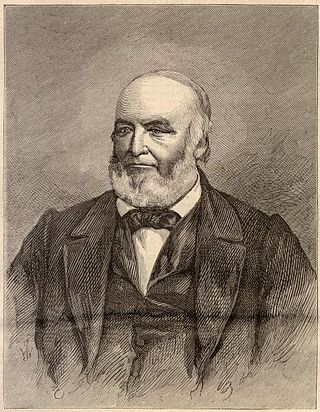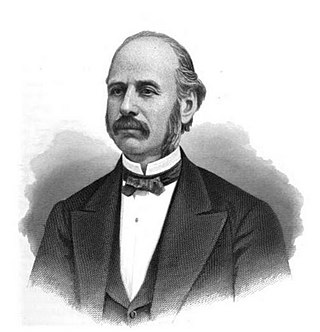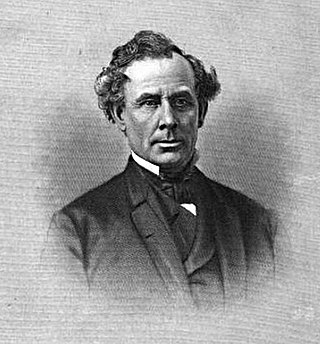I&B history
The I&B was incorporated in the U.S. state of Indiana on February 17, 1848. [1] Though the I&B once used the 4-foot-10-inch (1.47 m) Ohio gauge, it was quickly converted to standard gauge (4 feet 8.5 inches (1.435 m)). [2] Its counterpart, the B&I was chartered on February 25, 1848, in the U.S. state of Ohio. [3] A construction firm owned by Amasa Stone, Frederick Harbach, and Stillman Witt contracted to build the Ohio line. Construction began in 1849 in Indiana, and the portion of the line from Indianapolis to the Indiana-Ohio border (the I&B) was largely complete by 1851. Construction from the border east to Cleveland (the B&I) began in 1852, [5] and the line was complete in July 1853. [7]
The Indianapolis & Bellefontaine changed its name to the Indianapolis, Pittsburgh and Cleveland Railroad on December 19, 1854. [8] On March 14, 1856, the B&I entered into a joint operating agreement with the IP&C. [1]
John Brough, a newspaper publisher and president of the Madison and Indianapolis Railroad, was elected the B&I's president in 1862. Stillman Witt, one of the directors of the B&I, urged Brough to run for Governor of Ohio in 1864. Knowing that Brough could not afford the large reduction in pay, Witt agreed to become president of the B&I and forward his salary to Brough. Brough agreed, and Brough continued to receive the income from Witt until Brough's death on August 29, 1865.
On September 27, 1864, the B&I and the IP&C agreed to merge and form the Bellefontaine Railway. That agreement was filed with the Indiana Secretary of State on December 20 and with the Ohio Secretary of State on December 26. [1] [8]
On May 16, 1868, the Bellefontaine Railway was merged with the Cleveland, Columbus, and Cincinnati Railroad to form the Cleveland, Columbus, Cincinnati and Indianapolis Railway. [1] [8]

John Brough was a War Democrat politician from Ohio. He served as the 26th governor of Ohio during the final years of the American Civil War, dying in office of gangrene shortly after the war concluded.
The Cleveland, Cincinnati, Chicago and St. Louis Railway, also known as the Big Four Railroad and commonly abbreviated CCC&StL, was a railroad company in the Midwestern United States. It operated in affiliation with the New York Central system.

The Pittsburgh, Cincinnati, Chicago and St. Louis Railroad, commonly called the Pan Handle Route, was a railroad that was part of the Pennsylvania Railroad system. Its common name came from its main line, which began at Pittsburgh, Pennsylvania, crossed the Northern Panhandle of West Virginia, and continued west to Bradford, Ohio, where it split into a northern line to Chicago and a southern one through Indianapolis, Indiana, to East St. Louis, Illinois.

Amasa Stone, Jr. was an American industrialist who is best remembered for having created a regional railroad empire centered in the U.S. state of Ohio from 1860 to 1883. He gained fame in New England in the 1840s for building hundreds of bridges, most of them Howe truss bridges. After moving into railroad construction in 1848, Stone moved to Cleveland, Ohio, in 1850. Within four years he was a director of the Cleveland, Columbus and Cincinnati Railroad and the Cleveland, Painesville and Ashtabula Railroad. The latter merged with the Lake Shore and Michigan Southern Railway, of which Stone was appointed director. Stone was also a director or president of numerous railroads in Ohio, New York, Pennsylvania, Indiana, Illinois, Iowa, and Michigan.

Chauncey Rose was a successful American businessman of the 19th century.
The Columbus and Xenia Railroad was a railroad which connected the city of Columbus, with the town of Xenia in the state of Ohio in the United States. Construction began in October 1847, and the line opened in February 1850. Connecting with the Little Miami Railroad, it created the first rail route from Cincinnati to Columbus.
The Cleveland, Columbus and Cincinnati Railroad (CC&C) was a railroad that ran from Cleveland to Columbus in the U.S. state of Ohio in the United States. Chartered in 1836, it was moribund for the first 10 years of its existence. Its charter was revived and amended in 1845, and construction on the line began in November 1847. Construction was completed and the line opened for regular business in February 1851. The CC&C absorbed a small bankrupt railroad in 1861, and in May 1868 merged with the Bellefontaine Railway to form the Cleveland, Columbus, Cincinnati and Indianapolis Railway.
The Cleveland, Columbus, Cincinnati and Indianapolis Railway (CCC&I) was formed from the merger of the Cleveland, Columbus and Cincinnati Railroad (CC&C) with the Bellefontaine Railway in 1868. The Bellefontaine had been formed by a merger of the Bellefontaine and Indiana Railroad and the Indianapolis, Pittsburgh and Cleveland Railroad in 1864. Two key figures in its construction were Cyrus Ball and Albert S. White.
The CL&W Subdivision is a railroad line owned and operated by CSX Transportation in the U.S. state of Ohio. The line runs from a junction with the New Castle Subdivision at Sterling northwest to Lorain along a former Baltimore and Ohio Rail Road line. It junctions with the Cleveland Subdivision at Lester and the Greenwich Subdivision at Grafton.
Flint is an unincorporated community in Sharon Township, Franklin County, Ohio, United States, located north of downtown Columbus near the intersection of Flint and Park Roads. It was served by stations on the Cleveland, Columbus and Cincinnati Railroad and Sandusky and Columbus Short Line Railway, which opened through the area in 1851 and 1893, respectively. President Abraham Lincoln’s Funeral Train passed thru Flint-Worthington, en route to the Statehouse, on April 29, 1865.
The Cincinnati Northern Railroad was a railroad that stretched from Franklin, Ohio north to Jackson, Michigan, a distance of about 186 miles (299 km). It was acquired by the Cleveland, Cincinnati, Chicago and St. Louis Railway in 1901 and the New York Central Railroad several years later. Most of the line has since been abandoned.

The Cincinnati, Indianapolis and Western Railroad was established in 1915 as a reorganization of the Cincinnati, Indianapolis and Western Railway, which in turn had been created in 1902 as a merger of the Indiana, Decatur and Western Railway (ID&W) and the Cincinnati, Hamilton and Indianapolis Railroad (CH&I).
The following is a brief history of the North American rail system, mainly through major changes to Class I railroads, the largest class by operating revenue.
The Indianapolis Union Railway Company, is a terminal railroad operating in Indianapolis, Indiana. It was organized on May 31, 1850, as the Union Track Railway Company by the presidents of the Madison and Indianapolis Railroad (M&I), the Terre Haute and Richmond Railroad (TH&R), and the Indianapolis and Bellefontaine Railroad (I&B) for the purposes of establishing and operating joint terminal facilities in Indiana's capital city. The name of the company was changed to its present one on August 12, 1853. The next month, on September 20, Indianapolis Union Station opened its doors, becoming the first union railroad station in the world. Since 1999, the company has been owned and operated by CSX.

The Cleveland, Painesville and Ashtabula Railroad (CP&A), also known informally as the Cleveland and Erie Railroad, the Cleveland and Buffalo Railroad, and the Lake Shore Railroad, was a railway which ran from Cleveland, Ohio, to the Ohio-Pennsylvania border. Founded in 1848, the line opened in 1852. The railroad completed the rail link between Buffalo, New York, and Chicago, Illinois.

The Detroit, Monroe and Toledo Railroad (DM&T) was a shortline railroad which operated in the U.S. states of Michigan and Ohio. Opened in 1856, its main line ran from Detroit, Michigan, to Toledo, Ohio. The railroad leased itself to the Michigan Southern and Northern Indiana Railroad (MS&NI) in 1856. A 1914 merger which created the New York Central Railroad led to the DM&T's consolidation into the new road, ending its existence.

Stillman Witt was an American railroad and steel industry executive best known for building the Cleveland, Columbus and Cincinnati Railroad, Cleveland, Painesville and Ashtabula Railroad, and the Bellefontaine and Indiana Railroad. Through his banking activities, he played a significant role in the early years of the Standard Oil company. He was also one of the founding investors in the Cleveland Rolling Mill, a major steel firm in the United States.

The Cleveland and Mahoning Valley Railroad (C&MV) was a shortline railroad operating in the state of Ohio in the United States. Originally known as the Cleveland and Mahoning Railroad (C&M), it was chartered in 1848. Construction of the line began in 1853 and was completed in 1857. After an 1872 merger with two small railroads, the corporate name was changed to "Cleveland and Mahoning Valley Railroad". The railroad leased itself to the Atlantic and Great Western Railway in 1863. The C&MV suffered financial instability, and in 1880 its stock was sold to a company based in London in the United Kingdom. A series of leases and ownership changes left the C&MV in the hands of the Erie Railroad in 1896. The CM&V's corporate identity ended in 1942 after the Erie Railroad completed purchasing the railroad's outstanding stock from the British investors.










